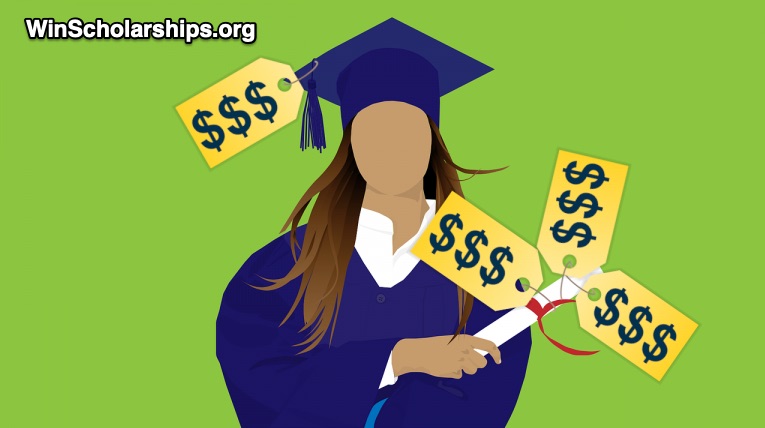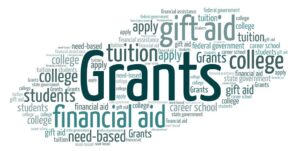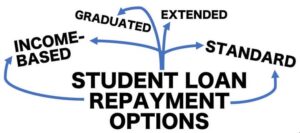
Graduating from college is an exciting milestone, but student loan debt can put a damper on the celebration. With the average student loan debt at nearly $40,000 per borrower, figuring out how to pay off student loans can be a daunting task. However, there are many strategies and methods that can help you chip away at your loans and eventually become debt-free.
Federal Student Loan Repayment Plans
Most student loans are federal loans, so taking advantage of federal repayment plans is a good starting point.
Standard Repayment Plan
With the standard repayment plan, you pay a fixed monthly amount for a 10-year term. This plan results in the lowest total interest paid over the life of the loan. Monthly payments may be higher compared to other plans, but you’ll pay off the loans faster.
Graduated Repayment Plan
This plan starts with lower monthly payments that gradually increase every two years. The repayment period is still 10 years, so you pay more toward the principal in the later years as your income grows.
Extended Repayment Plan
You can stretch out payments for up to 25 years with this plan. Monthly payments are lower, but you end up paying more interest over time. To qualify, you must have more than $30,000 in federal student loan debt.
Income-Driven Repayment Plans
Income-driven plans base your monthly payment on your discretionary income and family size. Popular options include:
- Income-Based Repayment (IBR): Payments capped at 10-15% of discretionary income. Forgiveness after 20-25 years of payments.
- Pay As You Earn (PAYE): Payments capped at 10% of discretionary income. Forgiveness after 20 years of payments.
- Revised Pay As You Earn (REPAYE): Payments capped at 10% of discretionary income. Forgiveness after 20-25 years of payments.
These plans provide reduced payments and the possibility of loan forgiveness for those struggling to make standard payments. You must re-certify your income each year to remain enrolled.
Public Service Loan Forgiveness (PSLF)
The PSLF program forgives the remaining balance on federal Direct Loans after making 120 qualifying monthly payments while working full-time for a qualifying public service employer. Examples include government organizations, 501(c)(3) nonprofits, AmeriCorps, and the Peace Corps. You must be enrolled in an income-driven repayment plan to qualify.
Refinancing and Consolidation
Refinancing and consolidating your student loans are two tactics to reduce interest rates and simplify payments.
Refinancing
With refinancing, you take out a new private loan to pay off your existing federal and private student loans. This lets you qualify for lower interest rates and better repayment terms based on your current finances and credit score. You lose federal benefits and protections by refinancing federal loans.
Consolidation
Consolidating federal loans combines multiple federal loans into one new Direct Consolidation Loan. This streamlines payments into one monthly bill but won’t reduce your interest rate. Consolidation lets you switch to income-driven repayment and qualify for PSLF. You cannot consolidate private loans into a Direct Consolidation Loan.
Make Extra Payments
Making payments in addition to your regular monthly amount can help you pay off loans faster. Even small increments help; adding an extra $100 a month can shave years off your repayment period and save thousands in interest. Any extra payment should be applied directly to the principal balance. Ways to free up money for extra payments include:
- Diverting raises, tax refunds, and bonuses toward student loans
- Pick up a side hustle for additional income
- Reduce expenses temporarily to funnel more to student loans
- Sell unused items and gifts to generate payoff funds
Employer Student Loan Repayment Assistance
Some employers now offer student loan repayment assistance (SLRA) as an employee benefit. With SLRA, the employer makes a direct payment to your student loan servicer each month to help pay down your debt. The amount and repayment terms vary by employer. SLRA payments are taxed at your regular income rate but can still make a significant dent in your student loans.
Federal and State Student Loan Forgiveness Programs
In addition to PSLF, other student loan forgiveness programs exist at the federal and state level:
- Teacher Loan Forgiveness: Up to $17,500 in forgiveness for teachers in low-income schools or educational service agencies.
- NHSC Loan Repayment Program: Repays up to $50,000 in student loans for medical professionals who work full-time at approved clinics in high-need areas for two years.
- State loan repayment programs: Many states offer loan forgiveness for grads who live and work in the state, especially in high-need occupations like nursing and teaching.
Student Loan Tax Deductions and Credits
There are some tax benefits related to student loan interest, including:
- Student loan interest deduction: Deduct up to $2,500 in student loan interest paid per year.
- Lifetime Learning Credit: Claim 20% of paid student loan interest as a tax credit up to $2,000.
- NYS Get on Your Feet Loan Forgiveness: Grads who live and work in NY can apply to have up to 24 student loan payments (up to $10,000) paid by the state.
While these don’t directly pay down your debt, they do help lower your tax bill to free up cash for repayment.
Pay Off Highest Interest Rate Loans First
Focus any extra payments on loans with the highest interest rates first, regardless of loan balance. This “debt avalanche” method saves the most money in interest compared to simply paying loans with the lowest balance first. Student loan interest rates vary greatly, so always target the most expensive debt first when you have extra cash.
Negotiate Your Student Loan Interest Rate
You can call your federal loan servicer or private lender and ask them to reduce your interest rate. They likely won’t lower it outright, but may offer a 0.25% – 0.50% reduction for enrolling in auto-pay or as a customer loyalty incentive. This small reduction can add up over the long run.
Deferment and Forbearance
If you’re struggling to make payments, deferment and forbearance temporarily suspend your federal loan payments. Deferment pauses payments, stops collection activity, and does not accrue interest on subsidized loans. Forbearance pauses payments but interest still accumulates. These options should be used as a last resort since interest still grows during forbearance.
Student Loan Forgiveness for Total Disability
Federal student loans can be forgiven if you become totally and permanently disabled. Private student loans may offer disability discharge as well. You must provide documentation of your disability from your physician. Forgiven debt may be taxable as income.
Student Loan Discharge in Bankruptcy
It is extremely difficult, but not impossible, to discharge student loans in bankruptcy. You must file a separate adversary proceeding and prove repaying the loans would cause “undue hardship”. This is hard to establish and most bankruptcy petitions to discharge student loans fail. It may be possible if you have a severe disability, very low income, and limited means to earn more in the future.
Forgiveness for Closed School or False Certification
If your school closes while you’re enrolled or shortly after you graduate, you may qualify to have your federal student loans forgiven under the closed school discharge program. If you were falsely certified as eligible for loans due to a school’s misconduct, you can have the loans discharged. The school would be held responsible for repaying the forgiven amount.
Pay Off Parent PLUS Loans
Parent PLUS loans used to finance a child’s education cannot be transferred to the student. The parent remains responsible for repayment. As a student, you can make payments toward the Parent PLUS loans yourself to lessen the burden on your parents. Communicate with your parents to ensure extra payments go toward the principal balance.
Joining the Military
Military personnel are eligible for student loan benefits, including the GI Bill to help pay for education costs and student loan repayment assistance programs. Under new laws, the Army, Navy, Air Force, and National Guard offer loan forgiveness up to $65,000 for those who enlist. Check each branch for their current education incentives and repayment options.
Volunteer Programs
Spending one or two years in a volunteer program such as AmeriCorps or the Peace Corps can earn you money to pay off loans. AmeriCorps provides up to $6,495 per year of service that can be applied directly to loans or future education. The Peace Corps offers loan deferral, partial cancellation, and preferential hiring status for federal jobs.
Crowdfund Your Loans
Crowdfunding platforms let you fundraise for personal causes from friends, family, and the general public. Fellow alumni may donate small amounts to help you repay your loans from their alma mater. Be transparent about exactly how the funds will be used. Possible sites include GoFundMe, ChipIn, CrowdRise, and GiveForward.
Income Share Agreements (ISAs)
ISAs are an emerging alternative to private student loans gaining popularity among startups. Investors provide an upfront lump sum to cover education costs in exchange for a percentage of your future income over a set period. It’s a way to raise funds without accruing interest or having a traditional loan.
Final Thoughts
Paying off student loans quickly takes focus and a debt repayment strategy tailored to your situation. Take advantage of federal repayment programs, look into refinancing and consolidation, and always target high-interest debt first when you have extra cash. Lowering your cost of living and increasing income can help direct more money toward student debt. While loans can seem overwhelming, consistency and discipline in repayment will help you become debt-free faster.







